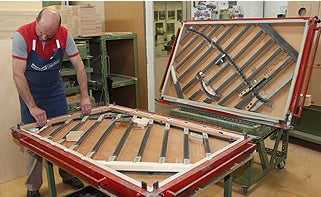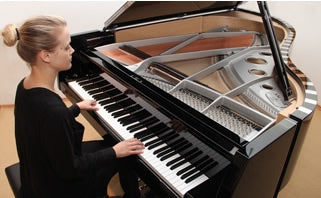

SAUTER has been the home of the fine art of beautiful sounds since 1819. Johann Grimm returned from Vienna after completing an apprenticeship under the most reputed piano makers of the time, Nannette Stein and Johann Andreas Streicher, to his home in Spaichingen and founded his own piano workshop which was continued after his death by his nephew Carl Sauter. They are still committed to the high demands of quality embodied by these names, who made instruments for Beethoven and other famous musicians.
It therefore comes as no surprise that the SAUTER pianoforte manufactory in Spaichingen, as the oldest piano manufactory, ranks among the best piano makers still in business in the world.
“Made in Germany” is a sign of quality recognized around the world. Sauter is one of the only Piano Manufacturers who craft all their instruments in house using only components made in Germany.
A piano is far more than just the sum of its parts. Tonal beauty derives from the harmonious interplay of countless details. And from the passion, experience and musical sensitivity of the piano manufacturer. One glance inside our pianos reveals many mysteries in sound.
Brilliant, clear sound is a hallmark of SAUTER pianos. That is why we insist on hand-crafting our instruments—given that our clients have appreciated this beauty in tone for nearly 200 years.
SAUTER's uncompromising musical quality can be seen in the harmonious interaction of decisive factors:
The secret of SAUTER's distinctive tone is the special "SAUTER spherical concavity®" of the sound boards in all upright and grand pianos designed by SAUTER. This permanently stable and tone-enhancing hollow is imparted using a unique manufacturing process, which can only be mastered through years of experience. The sound board is made of uniformly grown spruce wood from low mountain ranges and Alpine regions, which is particularly strong, yet light and flexible. The forms and positions of the structural slats are crucial for the precise concavity. They are glued together in one form and under immense pressure, to the sounding board, thereby stabilising the concavity, which then ensures they remain that way, without wanting to revert to their flat form. This imparts the desired membrane effect, creating the instrument's enduring clarity of tone. Researched and developed over many years, the manufacturing process used to fabricate the sound board is one of the defining characteristics that make the SAUTER sound uniquely lively and bright.

The energy from the vibrating strings is transmitted by the bridges glued to the sound board. The strings rest on these bridges with a specific pressure and are secured with pins so that as much vibrational energy as possible is transmitted to the sound board.
It is the fine-tuning of the actual string thickness, tension, and pressure on the bridge that determines the character and expressivity of the tone. If just one of these components changes too much over time—the concavity, for instance—then the soul of the sound is lost. The strings are made of high-quality steel alloys, which cannot be too hard or too soft. The bass strings are wrapped with 99.9% pure copper in order to achieve the necessary physical mass. To guarantee quality, we produce the strings ourselves in house.

The cast-iron frame (or cast plate), which we manufacture ourselves, must permanently stand up to enormous tensile forces of more than 20 tons exerted by the strings without bending or resonating. This can only be accomplished by an elaborately constructed cast-iron frame of the best workmanship, combined with a precise design such as that used by SAUTER.
The sound board is firmly attached to a strong notch. A notch is a heavy timber-frame construction at the back of an upright piano or on the underside of a grand piano. This allows the sound board to vibrate freely and the notch to repeatedly reflect the vibrational energy, thus prolonging the sound.

Unlike in the rational art of engineering, subjective feeling plays an important role in the manufacture of pianos. The piano manufacturer must first decide what he wants his piano to sound like and then seek ways to achieve that goal. The first step is to draft the string scale, i.e. lengths, cross-sections and tensile forces of the strings. This is the foundation of a piano—its genetic design, so to speak. Although computer programs are often used today to calculate the parameters, this core area of piano manufacturing includes a wide range of empirical tasks that require great musical sensitivity and substantial experience. These abilities, along with nearly 200 years of tradition, give SAUTER upright and grand pianos their clear and unmistakable tonal palette.

The hammer heads are not only the interface between the musician and the sounding body, but are also involved in the tonal design and therefore an integral part of the instrument's musical expressivity. The thickness, texture and shape of the felt, the haft and core of the hammers, and the method of bonding all play a part in determining the spectrum of overtones and, thus, the musical characteristics of the instrument. The optimum combination of factors cannot be calculated; it only can be achieved through intuition and experience.

The SAUTER piano makers voice the hammer heads using thin needles and ultra-fine sandpaper to create the unmistakable SAUTER sound in each and every SAUTER piano. In addition to skilled craftsmanship and experience, musical intuition is also essential to this process. Only a finely voiced instrument can entirely unfold its sonority and respond to the pianist’s nuances in playing.

SAUTER was the first piano manufacturer to introduce the modern steel reinforcing frame, which prevents any warping of the keyboard mechanism. As the most important part of the instrument, the role of the action is to take the energy generated by striking a key and to transform it into vibrational energy as precisely as possible by means of the hammers. Good pianos are rich in overtones, which develop according to the intensity of the strike. This is the source of expressivity. It is therefore of great importance to anyone who plays the piano to develop their touch in order to take advantage of the instrument's diverse tonal palette. This is only possible with a perfectly designed action that has been fabricated with the greatest possible accuracy and properly regulated.
Anyone visiting the SAUTER pianoforte workshop will appreciate that it takes more than just craftsmanship to put together more than 6,000 pieces of wood, leather, felt, and metal into a single mechanism for creating a sound with no musical limits.

To this day, our manufacturing philosophy sets the tone at SAUTER. Throughout the company's history, all the parts that contribute to the spirit of a piano have been crafted by hand. Our work is not dominated by machines, but by expert hands. At SAUTER, skill sets the pace and the scent of wood permeates the atmosphere. And you can hear, see and feel the craftsmanship. Come experience it for yourself!


Our story begins with Johann Grimm, a young carpenter's apprentice from Spaichingen who was drawn to the musical culture. In 1813 he traveled to Vienna to study piano building with Johann Andreas Streicher and his wife, Nanette Stein. Beethoven not only purchased his instruments from Streicher, but was also close friends with him, and Nanette ran the great composer's household for many years. In addition, Streicher was the piano teacher of Mozart's son and himself composed in the Viennese Classic style. (SAUTER recently released a CD of Streicher's Variations on an English Folksong.) Upon completing his six-year training, Grimm returned from the musical and instrument-building capital of the time full of enthusiasm and ideas. In 1819 he began building virginals in Spaichingen.
Grimm's successor and heir, his nephew Carl Sauter, built the workshop into a true factory employing a dozen apprentices in 1846, and soon it was numbered among the leading piano manufacturers in Swabia. After Carl's early death, Johann Sauter, who was only 17 at the time, took over the operation together with his mother. Johann traveled extensively, including to America, bringing back great motivation and innovations to the business. Broad-mindedness, a pioneering spirit and a passion for perfection have characterized SAUTER from the start.
A number of SAUTER inventions and technical improvements in piano manufacturing have been granted international patents. Johann Sauter also ushered in the transition from manufacturing virginals to the larger pianoforte. Carl Sauter II, who led the company beginning in 1909, was the force behind the expansion of the factory and its increase in production.

Delivering outstanding quality and improved piano models, the pleasing tone of the Sauter name became known throughout Germany. Hans Sauter, Carl Sauter's son, who took over company operations in 1948, applied new scientific discoveries, new technology and new materials to contemporary piano manufacturing. Soon the exquisite sound and design of SAUTER pianos were being exported throughout the world. Carl Sauter III, brother of Hans, took over the flourishing company in 1968 and constructed a new factory building between 1974 and 1983. With the development of the double repetition action, which allows for a particularly sensitive touch, and the introduction of the high-quality M series in the early 1990s, SAUTER continued on its successful course.


After Carl Sauter III's retirement in 1993, Otto Hott acquired a majority share of the company. With Ulrich Sauter serving as another managing director, a family member remained in the company as authorized officer and director of operations. This partnership marked the beginning of SAUTER’s successful re-orientation in the world market. Innovations positioned SAUTER squarely in the premium class internationally. The exclusive "SAUTER—designed by Peter Maly" series represents a design highlight created especially for modern living concepts. In 2000 SAUTER forged into the tonal dimension of internationally recognized concert grands with the Concert 275. A new era of exceptional piano manufacturing had begun.
Northwest Pianos welcomes you to come in and play this exquisite piano for yourself.